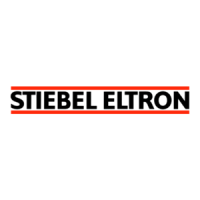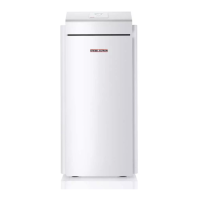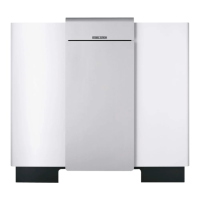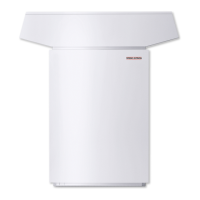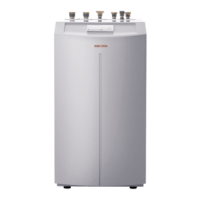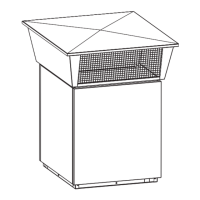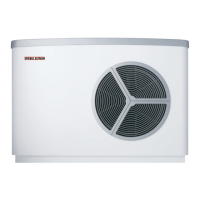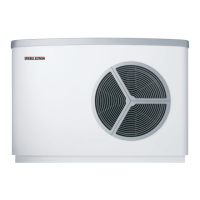COMMISSIONING
Menu
22 | WPM www.stiebel-eltron.com
Menu: SETTINGS
temperatures. The relationship between flow and return temper-
ature can be set in any proportions.
Example:
Setting Control Flow [%] Return [%]
0 Return temperature control 0 100
30 30 70
50 50 50
80 80 20
100 Flow temperature control 100 0
MAXIMUM RETURN TEMP
Select MAXIMUM RETURN TEMP to specify the temperature at
which the heat pump switches off in heating mode. This defines
when the heat pump is switched off for safety reasons, based on
the return temperature. In DHW mode the return temperature is
not scanned.
The idle time is specified in the parameter IDLE TIME (in the COM-
MISSIONING/ COMPRESSOR menu).
No fault message is shown on the display when this value is
reached.
MAXIMUM FLOW TEMPERATURE
Select MAXIMUM FLOW TEMPERATURE to specify the temperature
at which the heat pump switches off in heating mode. This defines
when the heat pump is switched off for safety reasons, based on
the flow temperature.
The idle time is specified in the parameter IDLE TIME (in the COM-
MISSIONING/ COMPRESSOR menu).
No fault message is shown on the display when this value is
reached.
FIXED VALUE OPERATION
Note
If fixed value operation is active, cooling mode is not
possible.
On/off heat pumps
In menu item FIXED VALUE OPERATION, you can specify the tem-
perature to which the set heating circuit temperature should be
constantly regulated. The outside temperature, set program times
and summer mode do not affect this.
Fixed value operation relates solely to the control characteristics
of heating circuit 1.
It is used, for example, on systems in which a constant flow tem-
perature is required, such as air heating systems.
Inverter heat pumps
In menu item FIXED VALUE OPERATION, you can specify the tem-
perature to which the set heating circuit temperature should be
regulated with selected flow proportion. The outside temperature,
set program times and summer mode do not affect this.
Fixed value operation relates solely to the control characteristics
of heating circuit 1.
It is used, for example, on systems in which a constant flow tem-
perature is required, such as air heating systems.
HEATING CIRCUIT OPTIMAL
When an Uponor DEM-WP module is connected, the heating curve
is dynamically optimised for the heat demand of individual rooms.
This involves modifying the preset heating curve by up to 50%
of its original value.
The parameter HEATINGCIRCUITOPTIMAL is only displayed when
the buffer operation parameter is set to OFF and neither a mixer
sensor nor an FE7 remote control are connected.
The parameter HEATINGCIRCUITOPTIMAL can be set to ON or OFF.
The default value is OFF. This parameter may be set to ON only if
an Uponor DEM-WP module is connected.
This function is only active inCOMFORT MODE, ECO MODE and
PROGRAMMED OPERATION.
FROST PROTECTION
Select FROST PROTECTION to specify the outside temperature at
which the frost protection function is activated.
Frost protection function prevents freezing of pipework, open
heating circuits and radiators as well as the heat pump.
The heating circuit pumps are started when the temperature falls
below the frost protection temperature.
The circulation pumps are switched off when the temperature
exceeds the frost protection temperature.
!
Material losses
The frost protection function cannot protect fully sealed
heating circuits and radiators from ice formation, damage
and consequential harm.
Ensure that all heating circuits are slightly open and
set the thermostatic valve to at least the frost protec-
tion setting.
REMOTE CONTROL FE7
This menu item is only displayed if the remote control is con-
nected.
With the remote control, the set room temperature for heating
circuit1 can be adjusted by ± 5°C.
The room sensor measures the actual room temperature. The
temperature is displayed in the heat pump manager. The actual
room temperature affects the control of heating circuit 1.
The remote control is only active in PROGRAMMED OPERATION.
ROOM INFLUENCE
In this menu item you set the degree of influence that the outside
temperature or current room temperature has on the control unit.
With weather-compensated control, the room is heated in relation
to the outside temperature and the set heating curve.
With room temperature-dependent control, the room is heated
consistently to the temperature set on the remote control.
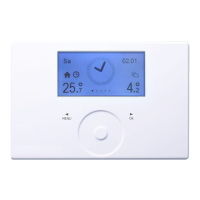
